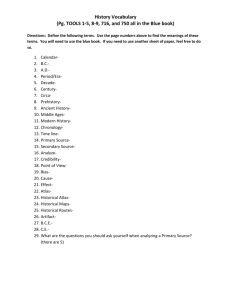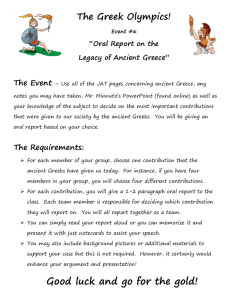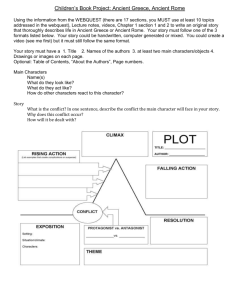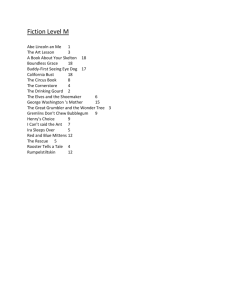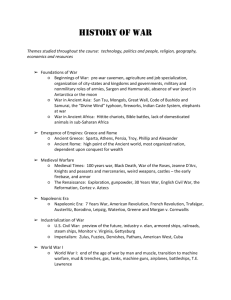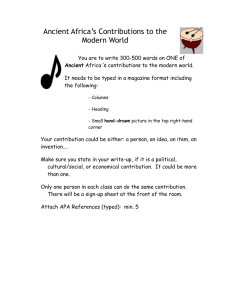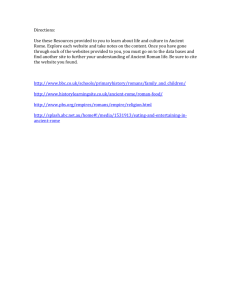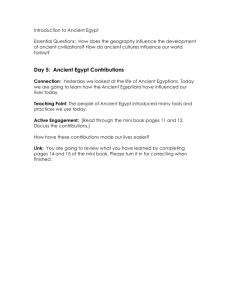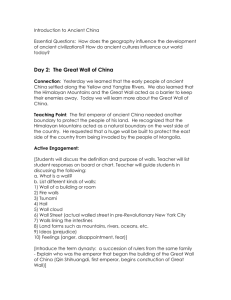Chapter 8 Operativeness of modern constraints in ancient verse
advertisement
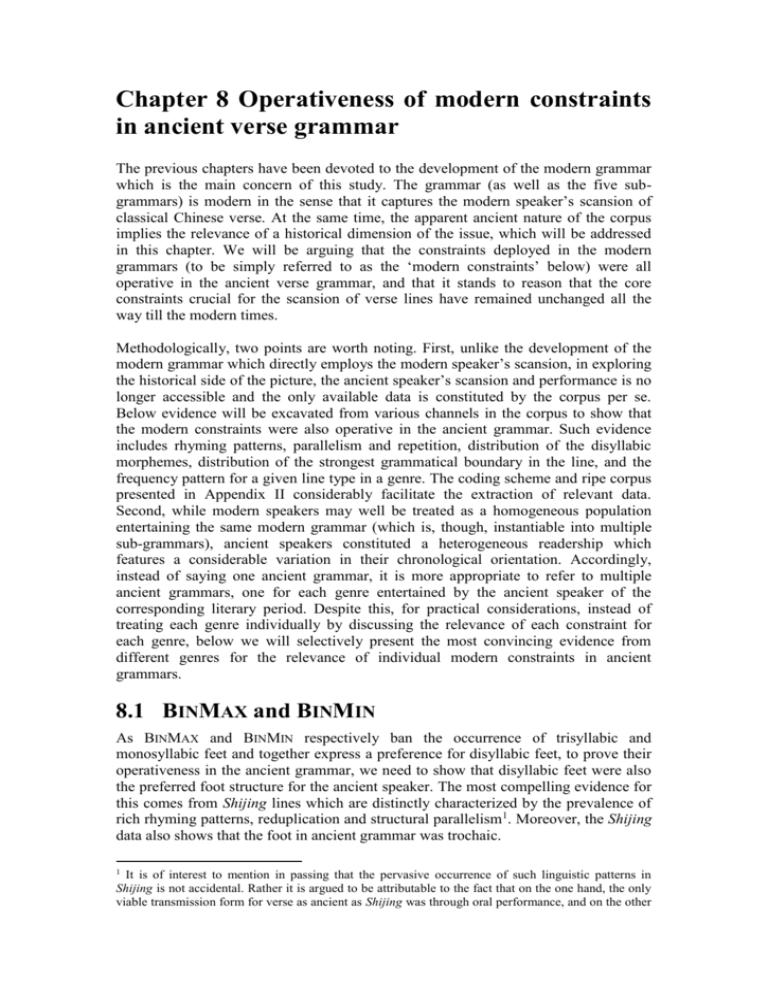
Chapter 8 Operativeness of modern constraints in ancient verse grammar The previous chapters have been devoted to the development of the modern grammar which is the main concern of this study. The grammar (as well as the five subgrammars) is modern in the sense that it captures the modern speaker’s scansion of classical Chinese verse. At the same time, the apparent ancient nature of the corpus implies the relevance of a historical dimension of the issue, which will be addressed in this chapter. We will be arguing that the constraints deployed in the modern grammars (to be simply referred to as the ‘modern constraints’ below) were all operative in the ancient verse grammar, and that it stands to reason that the core constraints crucial for the scansion of verse lines have remained unchanged all the way till the modern times. Methodologically, two points are worth noting. First, unlike the development of the modern grammar which directly employs the modern speaker’s scansion, in exploring the historical side of the picture, the ancient speaker’s scansion and performance is no longer accessible and the only available data is constituted by the corpus per se. Below evidence will be excavated from various channels in the corpus to show that the modern constraints were also operative in the ancient grammar. Such evidence includes rhyming patterns, parallelism and repetition, distribution of the disyllabic morphemes, distribution of the strongest grammatical boundary in the line, and the frequency pattern for a given line type in a genre. The coding scheme and ripe corpus presented in Appendix II considerably facilitate the extraction of relevant data. Second, while modern speakers may well be treated as a homogeneous population entertaining the same modern grammar (which is, though, instantiable into multiple sub-grammars), ancient speakers constituted a heterogeneous readership which features a considerable variation in their chronological orientation. Accordingly, instead of saying one ancient grammar, it is more appropriate to refer to multiple ancient grammars, one for each genre entertained by the ancient speaker of the corresponding literary period. Despite this, for practical considerations, instead of treating each genre individually by discussing the relevance of each constraint for each genre, below we will selectively present the most convincing evidence from different genres for the relevance of individual modern constraints in ancient grammars. 8.1 BINMAX and BINMIN As BINMAX and BINMIN respectively ban the occurrence of trisyllabic and monosyllabic feet and together express a preference for disyllabic feet, to prove their operativeness in the ancient grammar, we need to show that disyllabic feet were also the preferred foot structure for the ancient speaker. The most compelling evidence for this comes from Shijing lines which are distinctly characterized by the prevalence of rich rhyming patterns, reduplication and structural parallelism1. Moreover, the Shijing data also shows that the foot in ancient grammar was trochaic. 1 It is of interest to mention in passing that the pervasive occurrence of such linguistic patterns in Shijing is not accidental. Rather it is argued to be attributable to the fact that on the one hand, the only viable transmission form for verse as ancient as Shijing was through oral performance, and on the other 156 Classical Chinese Verse Grammar An overwhelming majority (1134 out of 1320 line) of Shijing lines are 4-syllable ones where such features are most telling. We first consider the rhyming patterns. To begin with, the (two or more) rhyming parts may occur either within one line or across lines, which entails a distinction between two types of rhyming, respectively referred to as intra- and inter-linear rhyming. The crucial fact is that for intra-linear rhyming in a 4syll line, the two rhyming syllables are invariably the second and the fourth ones, as in the following examples (where the rhyming syllables are marked out in bold form): (1) yuan2 ju1 yuan2 chu42 where live where reside ‘Where shall I live and where shall I reside?’ (2) ru2 qie1 ru2 cuo1 like carved like polished ‘(That gentleman is) so well-carved and finely polished’. By comparison, for inter-linear rhyming, the two rhyming units can be the last syllables of two lines3, hence monosyllabic, as in (3) she4 bi3 gao1 gang1, climb that high mound wo3 ma3 xuan2huang2. my horse weak dizzy ‘(I) climbed up that high mound and my horse felt weak and dizzy’. Or, interestingly, disyllabic, as in hand, the audience facing the oral poet was of a fluid and unstable nature. As a consequence, rhyming, repetition, parallelism, along with alliteration, assonance, balance, antithesis etc. become crucial in verbally transmitting the verse and attracting the audience by enhancing its memorability in the absence of orthographical aid. For an excellent discussion about the earliest poetry across cultures and the range of common features shared thereby, see Thompson (1978). 2 Note that the modern pronunciations are presented here in the pinyin form, which is the official romanization of Chinese characters, solely for convenience sake. Crucially, our perspective in this chapter shifts back to the ancient one, and the rhyming syllables that are marked out did rhyme in their ancient pronunciations which are not presented here. For many characters, their ancient phonological representations share the same nucleus as their modern ones, as is the case with the two rhyming syllables in (1) (and (3) below). By comparison, some syllables have undergone considerable changes in their phonological structures, as is shown by the two rhyming syllables in (2) and (4) below which obviously do not rhyme any more. For reconstruction work on ancient phonological structures of classical Chinese syllables, see Li (1979, 1986), Yu (1985), Lan et al. (1989), and Yu (1995). 3 Shijing displays a rich variety in terms of the position of the two lines involved in inter-linear rhyming: typically they are adjacent, but they can also be alternate lines in a stanza, such as the first and the third lines in a four-line stanza, or they can be corresponding lines across stanzas, such as the first lines in two neighboring stanzas. However, the position of the two rhyming lines has no immediate bearing upon the present discussion and will not be dealt with here. We will directly present the two rhyming lines without indicating their positions in the poem. Ancient Verse Grammar (4) 157 han4 zhi1 guang3 yi3 Han (state name) prt wide interj ‘Ah, the State of Han is so big’, jiang1 zhi1 yong3 yi3 river prt long interj ‘Ah, the river is so long’ (5) sheng4 bi3 xu1 yi3 climb that mound prt ‘Ah, I climb up that mound’, yi3 wang4 chu3 yi3 in order to see Chu state prt ‘Ah, in order to see the State of Chu’ These rhyming data provides valuable insights into the ancient scansion of the lines. First, the intra-linear rhyming such as (1) and (2) shows that in the ancient scansion, a 4-syll line was optimally parsed into two disyllabic feet so that the two rhyming syllables were actually the final syllables of the two feet thus parsed. That the other possible pair of syllables in a 4-syll line, say, the first and the third, or the second and the third, display no regular rhyming patterns indicates that other potential parsings were not realized. In other words, for a 4-syll line, (SS)(SS) was the optimal scansion for the ancient speaker as well, whereas other parsings such as (S)(SS)(S), (SSS)(S) or (S)(SSS) were sub-optimal. Thus, binary feet were also preferred over monary or ternary ones in the ancient scansion. In terms of constraints, this generalization offers support for that the two binarity constraints, i.e., BINMAX and BINMIN were also operative in the ancient grammar. Before we turn to inter-linear rhyming, it merits mentioning that additional evidence for the preference of binary feet in the ancient grammar comes from lexical reduplication, structural repetition and parallelism. More specifically, in a 4-syll line, reduplication, which contains two identical syllables, almost always occurs as the first and the second, or the third and the fourth syllables. This is illustrated below: (6) tao2 zhi1 yao1 yao1 peach prt thriving/redup. ‘The peach tree is thriving’, zhuo2 zhuo2 qi2 hua2 bright/redup. its blossom ‘Its blossoms are bright’. In contrast, it is very rare for the two syllables in a reduplication to appear as the second and the third syllables; only one out of the 1320 lines in our corpus has reduplication in such positions: 158 (7) Classical Chinese Verse Grammar fang1huan4 huan4 xi1 just melting/redup. interjection ‘(The two rivers) are just beginning to melt’. A similar pattern is displayed by repetition and parallelism, which is respectively characterized by a complete and partial structural identity, and which, like rhyming, can occur both intra- and inter-lineally. Specifically, in a 4-syll line, the unit involved in repetition or parallelism is always disyllabic. Examples abound, and below we just present verse lines respectively illustrating intra-linear repetition ((8)), intra-linear parallelism ((9)), inter-linear repetition and inter-linear parallelism ((10)): (8) le4 jiao1 le4 jiao1 revel countryside revel countryside ‘(They) revel in the countryside’. (9) wu4 jian3 wu4 fa2 not cut not saw ‘Do not cut or saw (the plum trees)’. (10) zuo3 you4 cai3 zhi1 left right pick them ‘I pick them on both my left and right sides’ zuo3 you4 mao4 zhi1 left right select them ‘I pick them on both my left and right sides’ Turning to inter-linear rhyming, we note that (3) offers little novel insight: the two rhyming syllables are the second syllables of the two corresponding feet across the lines. It is, after all, cross-linguistically common for the last syllables of verse lines to rhyme. By comparison, the rhyming units in (4) and (5) are evidently constituted by disyllabic feet, given what we have argued so far about the ancient scansion of 4-syll lines. However, it is immediately noteworthy that in such cases the first syllables in the two rhyming feet are always full, lexical syllables which differ and rhyme, whereas the second syllables in the two rhyming feet are always identical, and never full, lexical ones but in most cases, interjections (and occasionally object pronouns ‘zhi1’4). Examples of verse lines with disyllabic rhyming units whose second syllables are ‘zhi1’ are as follows: zuo3 you4 liu2 zhi1, left right float it4 ‘(It) floats everywhere (on the river)’, 4 wu3 mei4 qiu2 zhi1. awake asleep desire her ‘(I) desire her no matter when I am awake or asleep’. In such cases, the syllables preceding ‘zhi1’, which also rhyme, are always verbs who take ‘zhi1’ as their complements. In fact, as argued in Zuo (2000), ‘zhi1’ in this usage is and was underlyingly weak for modern and ancient speakers alike. We do not go into detail here due to lack of direct relevance. For more discussion, see Zuo (2000) (also Chen (2001) for arguments based on prose text). Ancient Verse Grammar 159 We argue that this rhyming data reveals two things. First, as far as the rhyming is concerned, only the first syllables in the disyllabic feet count, since generally speaking rhyming syllables are necessarily different5. Second, the rhyming between the first syllables in the disyllabic feet and the identity between the second ones therein render cases like (4) and (5) a clear example of feminine rhyme. It has been argued that ‘feminine rhyme occurs in trochaic meters or in hypercatalectic iambic (or anapestic) meters’ (Smith 1923: 126). Obviously, none of the lines in (4) and (5) are hypercatalectic (i.e. having an extra syllable at the end of a verse line). The occurrence of feminine rhyme in Shijing lines constitutes compelling evidence for the foot being trochaic, in addition to binary6. To recapitulate, we have argued on the basis of the rhyming patterns, repetition and parallelism in Shijing lines that binary and trochaic feet were also preferred in the ancient scansion. Evidence of a similar description from other genres can also be cited, which enables us to conclude that BINMAX and BINMIN were operative in the ancient grammar. As argued back in Chapter 2, BINARITY and TROCHEE constitute the bedrock for GOODFTINTERJ. Below, we are going to present more evidence from Shijing showing that the ancient speaker observed the same well-formedness pattern of feet containing interjection syllables as his modern counterpart. 8.2 GOODFTINTERJ The evidence for the operativeness of GOODFTINTERJ comes from the distribution of interjection syllables in 4-syll Shijing lines. Rather than freely occurring anywhere, interjection syllables display a very restricted distribution in such lines, namely, only at the second and/or the fourth positions but never at the first or the third ones7. Again 5 Haft (p.c.) points out to me that there are indeed cases in Chinese verse where the two rhyming syllables are identical; however, such cases are very rare, while here the final syllables are always identical, which says that they cannot be the real rhyming unit. In fact, in his online Glossary of Poetic Terms, Shubinski (2001) defines rhyme as ‘a type of echoing which utilizes a correspondence of sound in the final accented vowels and all that follows of two or more words, but the preceding consonant sounds must differ’ (my italics). Furthermore, the rhyming between the penultimate syllables calls for an explanation. 6 To get a better understanding of the connection of feminine rhyme with disyllabic trochees, compare the feminine rhyme in the 4-syll lines of (4) and (5) to that in the following 4-syll English verse line from Algernon Charles Swinburne’s (1837-1909) Song in Season: Thou whose beauty Knows no duty Due to love that moves thee never…. A further argument for the connection between feminine rhyme and trochee in the Chinese context comes from Chao’s (1927) ‘polysyllabic rime’ (Duanmu, p.c.) which requires the identity from the stressed syllable to the end of the foot. And notably in such cases, the non-head syllable is clearly weak, as is shown in the neutralization of its tone as well as reduction of segmental quality. This is illustrated below (where neutral tones are indicated by the digit 0): zhe4 shi4 (ta1 de0), bu3 shi4 (fa1 de0) ‘This is his, not issued’. zhe4 ge4 (huai4 le0), ba3 ta1 (mai4 le0) ‘this one is broken; sell it’. 7 One further interesting observation regarding the distribution of interjection syllables in 4-syll Shijing lines is that such syllables seem to occur much more readily at the fourth position than at the second one. If there is only one interjection in the line, then it is bound to be at the fourth position, while a line with an interjection at the second position always has another one at the fourth position. There are no 160 Classical Chinese Verse Grammar examples abound: the occurrence of the interjection at the second and fourth positions is typically accompanied by intra-linear repetition or parallelism, as in the following lines: (11) you1 zai3 you1 zai3 pensive interj pensive interj ‘Ah, how pensive I am’. (12) kuan1 xi1 chuo4 xi1 broad interj generous interj ‘Ah, how broad-minded and generous (he is)’ We already argued above that the ancient scansion of 4-syll lines was (SS)(SS), each foot being trochaic. Therefore, the fact that interjection syllables can only occur at the second and fourth positions in such lines shows that they cannot serve as the head of a trochee. This constitutes evidence that in comparison to lexical syllables which were strong, interjection syllables were underlyingly weak for the ancient speaker in the same way as they are for the modern speaker. It follows from this that for the ancient speaker, the well-formedness pattern of feet containing interjection syllables must have been the same as that for the modern speaker, namely, the interjection syllable could only occur as the non-head in the disyllabic trochee. In terms of OT constraints, this generalization is then directly translatable into GOODFTINTERJ, proposed for the modern grammar. Indeed, the identity between the interjection syllables between the lines featuring feminine rhyme as illustrated in (4) and (5) above also hints that such syllables have to be adjoined to the preceding lexical syllables and cannot form monosyllabic feet on their own. 8.3 ANCHOR-ISBOPHP To argue for the relevance of ANCHOR-ISBOPhP, we need to show that when an SB (strongest boundary) is present in the grammatical structure of the line, namely, when a line is of a bi-directional structure, this boundary must emerge in the scansion of the line as the PhP boundary. As SB represents the biggest grammatical break in the line, we assume that its prosodic correspondent also constitutes a higher-level prosodic boundary, which can only be PhP boundary given that the line is prosodically an IP. Thus, we only need to prove that the SB in a line, if present, must have a correspondent in its scansion. The most convincing evidence comes from the distribution of SB boundaries in Ci lines. Here the analytical convenience offered by the coding scheme presented in lines in our corpus with only one interjection syllable at the second position. This, we argue, suggests that the second position in a 4-syll line is somewhat stronger than the fourth position, which further constitutes evidence for trochee at the prosodic level higher than foot, presumably PhP level. This is illustrated as follows (with S and W respectively standing for Strong and Weak): S S (σ W W σ) S (σ PhP level trochee W σ). Foot level trochee Ancient Verse Grammar 161 Appendix II becomes evident: the SB is represented as the line-medial coding 4 boundary (to be simply referred to as the M4 boundary) whose distribution is straightforwardly shown in the ripe corpus presented there. To begin with, the operativeness of BINMAX and BINMIN argued above (which can also be independently supported by the distribution of disyllabic morphemes in Ci lines, see Zuo (in prep)) enables us to infer the ancient scansion of 4- and 6-syll lines as respectively (SS)(SS) and (SS)(SS)(SS). Now consider the SB, i.e. M4 boundary, distribution in these two line types. For 4-syll lines, this issue is trivial, since only the coding 4 boundary after the second syllable qualifies as an SB8, and given the ancient scansion as (SS)(SS), clearly ANCHOR-ISBOPHP was met. The SB distribution pattern in 6-syll Ci lines is more telling, as shown below. The hyphen (-) is used to indicate the relevant boundary. (13) Distribution of SB in 6-syll Ci lines Distribution of SB SS-SSSS SSS-SSS SSSS-SS Frequency 72 0 14 Evidently, of the three possible positions for SB in a 6-syll line, SB only occurs after the second or the fourth syllable, never after the third syllable. Given the optimal scansion of 6-syll lines as (SS)(SS)(SS) reached independently above, the nonoccurrence of SB after the third syllable constitutes compelling evidence that SB must always surface in the output. Otherwise, it would appear enigmatic why SB does not occur after the third syllable, which is a theoretically possible position for SB. This way, we have argued for the active engagement, and in fact, inviolability, of ANCHORISBOPHP in the ancient grammar. 8.4 NONFINALITY (PCAT) As suggested earlier, *IP-FINAL-MONOFT and *PHP-FINAL-MONOFT are treated as differently parametrized versions of NONFINALITY (PCAT) and indeed, as the right edge of the line-final PhP necessarily coincides with that of the IP, a ban of PhP-final monosyllabic feet would encompass a ban of IP-final ones. Hence we only need to prove the operativeness of *PHP-FINAL-MONOFT in the ancient grammar. Evidence for this comes from the distribution of lexical items whose constituting syllables are inseparable in Ci lines. Such lexical items include disyllabic morphemes, place and person names, reduplications, and the boundary between its constituting syllables is coded as 1 in the coding scheme (see Appendix II). We assume that the two component syllables in such lexical items resist to be separated in scansion. This can be understood by considering the two syllables in a disyllabic morpheme: a foot cannot break up a disyllabic morpheme. Therefore the distribution of coding 1 boundaries in the corpus would offer a hint to the ancient scansion of the line and accordingly the relevance of *PHP-FINAL-MONOFT. 8 Coding 4 boundaries at both the line-initial and penultimate positions do not count as M4 ones, because such lines have a unidirectional grammatical structure. 162 Classical Chinese Verse Grammar As *PHP-FINAL-MONOFT imposes a ban on the occurrence of monosyllabic feet at the end of PhP, to argue for its relevance to the ancient scansion apparently involves the PhP boundary delimitation by the ancient speaker. Regarding this issue, we assume that the sub-hierarchy proposed for PhP boundary delimitation in the modern grammar equally applied in the ancient one. Furthermore, as shown in the last section, the SB in a line, if present, must correspond to the PhP boundary in the output. At the same time, in addition to this line-medial PhP boundary, the end of the line, i.e. the IP, constitutes another PhP boundary. Hence, to show that *PHP-FINAL-MONOFT played a role in the ancient grammar, we need to consider the occurrence, or, for that matter, non-occurrence, of monosyllabic feet at the end of both these PhP boundaries. We start by showing that *PHP-FINAL-MONOFT was operative for the line-final PhP boundary, which was simultaneously the IP boundary. This is evidenced in the distribution of coding 1 boundaries in 3- and 4-syll Ci lines, where the PhP boundary was (and is) co-terminous with the IP boundary. The distribution is charted below: (14) Distribution of coding 1 boundary in the 3-syll Ci lines Distribution of the coding 1 boundary S-SS SS-S Frequency 0 7 As a foot cannot cut into a disyllabic morpheme, this highly regular pattern strongly indicates that 3-syll lines were scanned as (S)(SS) rather than (SS)(S)9. The distribution of the coding 1 boundary in 4-syll Ci lines presents a similar pattern: (15) Distribution of coding 1 boundary in the 4-syll Ci lines Distribution of the coding 1 boundary S-SSS SS-SS SSS-S Frequency 6 0 8 By the same token, this readily suggests (SS)(SS) as the ancient scansion. Given that the PhP boundary in both 3- and 4-syll lines coincides with the IP boundary, i.e. (S)(SS)| and (SS)(SS)|, this shows that *PHP-FINAL-MONOFT, or for that matter, *IPFINAL-MONOFT, was operative in the ancient grammar. We move on to consider the relevance of *PHP-FINAL-MONOFT at the line-medial PhP boundaries. Obviously, a line has to be at least five syllable long in order to have a line-medial PhP boundary in addition to the line-final one. Furthermore, for analytical reason, we will only consider those lines containing an SB: the PhP boundary in such cases can be determined directly without resort to the foot-level 9 An independent and compelling piece of evidence for (S)(SS) being the optimal scansion of 3-syll lines by the ancient speaker comes from the extremely popular verse piece San Zi Jing (Three Word Doctrine) which was composed by Wang Yinglin in the Song dynasty, i.e. the same historical period as when Ci was composed. It is solely comprised of 3-syll lines, and of the total 377 lines, 329 are of the structure S[SS], and furthermore 27 of the remaining 48 lines are for enumerative purpose, leaving only 21 lines of the structure [SS]S. We argue that the overwhelming predominance of the S[SS] structure strongly hints at the recitation of the lines as (S)(SS), thus avoiding the IP-final monosyllabic foot. 163 Ancient Verse Grammar parsing thanks to the operativeness (and in fact inviolability) of ANCHOR-ISBOPhP in the ancient grammar argued above. In the same line of reasoning, the evidence once again comes from the coding 1 boundary distribution before this pre-determined PhP boundary which corresponds to the SB. As is evident from the ripe corpus for Ci presented in Appendix II, only 6and 7-syll lines contain coding 1 boundaries. Furthermore, in both line types, the SB occurs exclusively after the second or the fourth syllable, and so does the corresponding PhP boundary. Hence for coding 1 boundaries, only the three possible positions provided by the first four syllables are relevant. The distribution pattern is as follows. For clarity sake, the PhP boundaries are marked out with ‘|’ and the relevant positions where coding 1 boundaries occur with the hyphen ‘-’. (16) Line type 6-syll lines PhP boundary determined by SB SS|SSSS SSSS|SS 7-syll lines SS|SSSS SSSS|SSS Distribution of coding 1 boundaries within the first PhP S-S|SSSS S-SSS|SS SS-SS|SS SSS-S|SS S-S|SSSS S-SSS|SSS SS-SS|SSS SSS-S|SSS Frequencies 7 1 0 2 2 7 0 5 It is notable that for both line types, when the PhP boundary falls after the fourth syllable, the distribution of coding 1 boundaries in the first PhP displays a similar pattern to that in 4-syll lines (cf. (15)): the coding 1 boundary never occurs between the second and the third syllables. Together with the ancient speaker’s binarity preference argued above, this pattern, we suggest, strongly indicates that in such cases, the first PhP was parsed by the ancient speaker as (SS)(SS), rather than otherwise, say, (S)(SS)(S). As for the lines where the PhP boundary falls after the second syllable, the two syllables in the first PhP were parsed into a disyllabic foot due to the foot binarity preference. In both cases, the first PhP always ends with a disyllabic foot and PhP-final monosyllabic feet were avoided. Thus we have argued for the avoidance of monosyllabic feet at the end of both PhP’s in the IP on the basis of the coding 1 boundary distribution. Translated into a constraint, this is tantamount to the operativeness of NONFINALITY (PCAT) with PCat being both IP and PhP in the ancient grammar. 8.5 GOODFT’XI’ GOODFT’XI’ essentially specifies the well-formedness pattern of feet containing ‘xi’: (Sxi) and (xi) are well-formed and (xiS) ill-formed. Accordingly to argue for the relevance of GOODFT’XI’ in the ancient grammar, we need to provide evidence for the observation of this well-formedness pattern in the ancient scansion. To begin with, that ‘xi’ can form a legitimate foot by itself is obvious from the fact that 5-syll Jiuge lines were scanned as (SS)(xi)(SS), supported by the following three 164 Classical Chinese Verse Grammar pieces of evidence. First, in all such lines, ‘xi’ occurs exclusively after the second syllable, i.e. SSxiSS. Given the foot binarity preference in the ancient grammar, the two syllables on each side of ‘xi’ were parsed into a disyllabic feet. Second, the two disyllabic units flanking ‘xi’ typically constitute structural parallelism, illustrated by the pairs ‘yao2 xi2’ and ‘yu4 zhen3’, ‘gao1 fei1’ and ‘an1 xiang2’ shown below: (17) [yao2 xi2] xi1 [yu4 zhen3] gem mattress xi jade pillow ‘Ah, the mattress is ornamented with gems and the pillows with jades’ (18) [gao2 fei1] xi1 [an1 xiang2] high fly xi stable flow ‘Ah, how high you fly, and how stable you flow (in the heaven)’ The third piece of evidence comes from the distribution of coding 1 boundaries in 5syll lines: such boundaries only occur between the two syllables on either side of ‘xi’ and never straddle ‘xi’. The reasoning behind the use of this evidence was discussed in Section 8.4 above. Consider the coding 1 boundary between the two reduplicative syllables in the following examples: (19) hu4 hu4 xi1 qiu1 feng1 onomatopoeia10 xi autumn wind ‘Ah, the autumnal wind is blowing heavily’ (20) fei1 long2 xi1 pian1 pian1 fly dragon xi elegant ‘Ah, how elegantly the dragon is flying’ These converging pieces of evidence show that the two syllables on each side of ‘xi’ in a 5-syll Jiuge lines formed a foot. Assuming that PARSE-SYL was also inviolable for the ancient speaker, the only possible parsing for this lone ‘xi’ is to form a monosyllabic foot on its own. Thus (xi) was legitimate in the ancient scansion. Now we consider the illegitimacy of (xiS). That ‘xi’ cannot head a disyllabic foot is evident from the mere absence of ‘xi’ at the beginning of a line. This is not only true with Jiuge lines, but also so with the lines of all the other Chuci sub-genres. In this connection, we assume that line-initial monosyllabic foot (xi) was also unwelcome in the ancient scansion for the same reason as proposed in Chapter 3. Indeed, the distribution of coding 1 boundaries illustrated in (20) above also shows that the final three syllables could not have been possibly scanned as (xiS)(S). Finally, the well-formedness of (Sxi) is straightforward given that we argued in Section 8.1 that the foot in ancient scansion was trochaic: (Sxi) where a strong full lexical syllable serves as the head was evidently a well-formed trochee. To summarize, we have shown that in the ancient scansion, ‘xi’ could either form a monosyllabic foot on its own or be adjoined to a preceding full lexical syllable to 10 ‘Hu4 hu4’ is an onomatopoeic reduplication vividly describing the sound of heavy wind blowing. Ancient Verse Grammar 165 form a disyllabic trochee, but could not serve as the head of a disyllabic foot. This is exactly what GOODFT’XI’ is all about. Thus, GOODFT’XI’ was operative in the ancient grammar. 8.6 ANCHOR and ALIGNR (FT, IP) Evidence for ANCHOR and ALIGNR (FT, IP) comes from the frequency pattern in the corpus: for a given line type (in terms of syllable numbers) in a given genre, lines of different grammar structures occur with different frequencies. This is clearly shown in the ripe corpus in Appendix II where the analytical convenience offered by the coding scheme becomes evident again. The line of argument for the operativeness of ANCHOR and ALIGNR (FT, IP) in the ancient grammar is as follows. To begin with, following Kiparsky (1977) and Youmans (1989), we assume that in a sufficiently large corpus, a correlation exists between the frequency of grammatical structures beyond a certain threshold and the metrical harmony of lines of such structures as cognized by the native speaker. This enables us to conclude that the most frequent grammatical structure in each genre was cognized as metrically most harmonious by the ancient speaker. Second, we assume that as in the case of the modern grammar, the metrical harmony of a certain line type in a given genre cognized by the ancient speaker was also grounded in the ancient grammar for this genre. Accordingly, the analytical procedure is the same as that used in formally accounting for the metrical harmony of the modern speaker, in particular the use of the tableau des tableaux; the only difference lies in that while for the modern grammar, the optimal parse, i.e. the metrically most harmonious line in each genre can be directly elicited from the speaker, for the ancient grammar, it can only be indirectly inferred from the frequency pattern distinctly exhibited in the ancient corpus which presumably reflects the ancient speaker’s cognization of metrical harmony. Third, it should become evident from the discussion in the previous sections of this chapter that with the exception of BINMIN, all the other constraints discussed therein, i.e. BINMAX, GOODFTINTERJ, ANCHOR-ISBOPHP, NONFINALITY (PCAT) and GOODFT’XI’, were not only operative but in fact also inviolable in the ancient grammar. BINMIN was obviously dominated by BINMAX as monosyllabic feet were allowed but not trisyllabic ones. Below we are going to show that the frequency data, which is apparently ancient in nature, does provide evidence for the operativeness of the two violable constraints ANCHOR and ALIGNR (FT, IP), although it falls short of enabling us to spell out the ancient grammar in full. The most compelling evidence for the relevance of ANCHOR in the ancient grammar comes from the frequency pattern in 4-syll Shijing lines, which, as evident from the ripe corpus in Appendix II, occupy an overwhelming percentage (85.91%) of the Shijing corpus and its sub-corpus is thus sufficiently large. Below the tableau des tableaux is constructed in the same spirit as that used in the modern grammar. The optimal parse was the most harmonious one for the ancient speaker, i.e. the parse corresponding to the most frequent grammatical structure in the 4-syll Shijing line sub-corpus, i.e. [SS][SS] (corresponding to the coding types 2425, 1425, 2415, 1415, 2435 and 3435 in the ripe corpus). The ancient scansion for all 4-syll Shijing lines was 166 Classical Chinese Verse Grammar (SS)(SS)|, as discussed in Section 8.1 above. The solid line on the left of ANCHOR shows the inviolability of the bunch of constraints dominating it. (21) 4-syll Shijing lines ANCHOROI [SS][SS] (SS)(SS)| S[S[SS]] (SS)(SS)| [S[SS]]S (SS)(SS)| [[SS]S]S (SS)(SS)| S[[SS]S] (SS)(SS)| ANCHORIO ANCHORISBOPHP NONFINAL ITY GOODFT INTERJ BINMIN BINMAX Candidate parses *! *!* * *! *!* * Here ANCHOR is crucial in selecting [SS][SS] as the winner. Further evidence for the relevance of ANCHOR is provided by the frequency pattern of 5-syll Guti lines, as shown below: (22) 5-syll Guti lines ANCHOROI ANCHORIO ANCHORISBOPHP NONFINAL ITY GOODFT INTERJ BINMIN [SS][S[SS]] (SS)(S)(SS) [SS][[SS]S] (SS)(S)(SS) S[S[SS]S] (SS)(S)(SS) S[S[S[SS]]] (SS)(S)(SS) S[[SS][SS]] (SS)(S)(SS) BINMAX Candidate parses * * *! * * *!* * * *! * *! * Here again ANCHOR is crucial in accounting for the metrical harmony experienced by the ancient speaker reflected via the frequency pattern. In other words, the most frequent lines were those best satisfying ANCHOR. If ANCHOR were irrelevant in the ancient grammar, then the highly regular and apparently non-trivial frequency pattern would remain mysterious. Evidence for the operativeness of ALIGNR (FT, IP) in the ancient grammar comes from the frequency pattern of 5-syll Ci lines where the grammatical structure [SS][S[SS]] (corresponding to the coding types 24325, 14325 and 14325 in the ripe corpus) occurred most frequently. The dotted line between ANCHOR and ALIGNR (FT, IP) shows the lack of evidence for their ranking. 167 Ancient Verse Grammar (23) 5-syll Ci lines ALIGNR (FT, IP) ANCHOR -OI ANCHOR -IO ANCHOR -ISBOPHP NONFIN ALITY GOODFT INTERJ BINMIN a. [SS][S[SS]] (SS)|(S)(SS) b. S[[SS][SS]] (S)(SS)|(SS) c. [SS][[SS]S] (SS)|(S)(SS) BINMAX Candiate parses * 5 * 6! * *! * 5 Here we see both ANCHOR and ALIGNR (FT, IP) are crucial in accounting for the highest frequency enjoyed by lines of the structure [SS][S[SS]]. If ALIGNR (FT, IP) were irrelevant in the ancient grammar, then one would expect equal frequency between S[[SS][SS]] and [SS][S[SS]], which runs against the fact. As a final note, we wish to add that the operativeness of ANCHOR and ALIGNR (FT, IP) in the ancient grammar is evident if we consider how they should be interpreted informally. ANCHOR is in essence a constraint responsible for the boundary matching between the grammatical and prosodic structures of the verse line and as such embodies the syntax-prosody interaction. As we are only interested in the performance style where the ancient speaker parsed the line with a sensitivity to the structure and meaning of the verse line rather than the linguistically uninteresting ‘dumb’ scansion which blindly chops the line into binary units (Jackendoff 1989; also referred to as the ‘minstrel’ scansion in Tsur 1998), it stands to reason that ANCHOR was in general operative in the ancient speaker’s scansion (with the Jinti genre being a possible exception). On the other hand, ALIGNR (FT, IP), in requiring the alignment between the right boundaries of the feet contained in the line and the right boundary of the IP, i.e. the line end, actually requires that all feet in the line are flushed as much to the right as possible. This, we suggest, boils down to the requirement that the directionality of parsing the line be from left to right, which is shown to be true for the prosodic parsing in general for Chinese speakers (Chen 2000). 8.7 Concluding remarks In this chapter we have argued, solely on the basis of data from the ancient corpus, that all constraints deployed in the modern grammar also played a role in the ancient ones. Although the data falls short of allowing us to fully spell out the ancient grammars, there are nonetheless certain indications that the ancient grammars most likely borne a considerable resemblance to the modern one11. One is that as we have shown, those constraints that are inviolable in the modern grammar were also inviolable in the ancient ones. Another indication comes from the highly notable fact that for all the genres, the most frequent structures in the corpus (when the sub-corpus for the line type is sufficiently large), i.e. those cognized as being metrically most harmonious by the ancient speaker, always coincide with the most harmonious ones cognized by the modern speaker. This consistent convergence cannot be accidental; rather we believe that it strongly suggests that the ancient speaker might have shared 11 Actually, in his work on the metrics of classical Chinese verse, Duanmu (2001) assumes, without much argument, that the prosodic structure ‘should be similar’ for the modern and ancient speakers. The discussion in this chapter may be understood as substantiating this assumption. 168 Classical Chinese Verse Grammar the same grammar as the modern one and that the core constraints responsible for verse line scansion have been passed on from the ancient all the way to the modern times, and insofar as the verse grammar is concerned, little has changed 12. We leave the full articulation of the ancient grammar for each genre for future research. 12 An alternative way to comprehend the resemblance between the modern grammar and the ancient one is that the modern speaker’s verse grammar is in fact indirectly shaped by the ancient speaker’s via the various linguistic patterns built into the ancient corpus, such as the rhyming patterns, distribution of the coding 1 and 4 boundaries, and the frequency profile. The influence of the frequency pattern on developing the modern speaker’s grammar is particularly effective: for a given line type, the most frequently occurring grammatical structure, which was apparently most preferred by the ancient speaker, receives most exposure with the modern speaker, who most likely grows familiar to such lines and accordingly experiences, almost in a hereditary way, them to be metrically most harmonious. This convergence of metrical harmony judgment serves to mold the modern grammar in such a way that it resembles the ancient counterpart.
